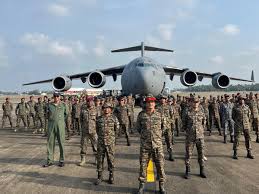
Amid Trade Tensions, Alaska War Games Strengthen India-US Defence Ties

 :
| Updated On: 03-Sep-2025 @ 12:36 pm
:
| Updated On: 03-Sep-2025 @ 12:36 pmSHARE
Indian and American troops have come together at Fort Wainwright in Alaska for the 21st edition of Exercise Yudh Abhyas, a two-week-long annual joint military exercise held from September 1 to 14. This exercise is a significant marker of the steady growth in strategic and defence cooperation between India and the United States, even as both countries face occasional strain in their relations over issues such as trade tariffs, India’s import of Russian oil, and stalled trade negotiations. Despite these political and economic disagreements, the defence relationship remains robust and continues to expand.
The Indian Army contingent consists of personnel from a battalion of the Madras Regiment, while the U.S. Army contingent includes soldiers from the 1st Battalion, 5th Infantry Regiment “Bobcats” of the Arctic Wolves Brigade Combat Team, 11th Airborne Division. This edition of the exercise focuses on enhancing interoperability between the two armies through training in diverse tactical and operational domains.
According to India’s Ministry of Defence, the participating troops will engage in a wide range of tactical drills and training exercises, including heliborne operations, use of surveillance equipment, deployment of unmanned aerial systems (UAS), rockcraft, mountain warfare, casualty evacuation, and combat medical support. Additionally, the exercise incorporates the integrated use of artillery, aviation assets, and electronic warfare systems.
Specialized working groups led by subject-matter experts from both sides will cover critical areas such as UAS and Counter-UAS operations, information warfare, communications, and logistics. The exercise will culminate in jointly planned and executed tactical manoeuvres, ranging from live-fire drills to high-altitude warfare scenarios. A significant aspect of this training is its emphasis on enhancing capabilities for United Nations peacekeeping operations and strengthening preparedness for multi-domain security challenges.
The fact that the exercise is taking place amid trade and tariff tensions underscores that India-U.S. defence ties are unaffected by economic disagreements. This comes despite U.S. President Donald Trump’s repeated observations that India continues to purchase most of its oil and military hardware from Russia rather than the United States.
The military collaboration also extends beyond exercises. Just a week before Yudh Abhyas began, the U.S. submarine support ship USS Frank Cable visited Chennai on a scheduled port call. This was the second such visit in two years by a Military Sealift Command ship to the region. USS Frank Cable provides expeditionary maintenance, services, and logistics support to submarines and surface vessels deployed across the Indo-Pacific, further highlighting the operational cooperation between the two navies.
Defence ties have been systematically strengthened through a series of key agreements. In August of the previous year, India and the U.S. signed a Security of Supply Arrangement (SOSA) and a Memorandum of Agreement on Liaison Officers. These agreements build on earlier frameworks such as the 2013 Joint U.S.-India Declaration on Defence Cooperation and the 2015 Framework for the U.S.-India Defence Relationship, both of which articulated a vision for closer defence ties.
From 2016 to 2020, several landmark agreements were signed:
-
LEMOA (Logistics Exchange Memorandum of Agreement, 2016) enabling logistical support between the two militaries.
-
COMCASA (Communications Compatibility and Security Agreement, 2018) allowing secure communication interoperability.
-
BECA (Basic Exchange and Cooperation Agreement, 2020) facilitating geospatial intelligence sharing.
India has also made significant military procurements from the United States, including MH-60R Seahawk multi-role helicopters, M777 ultra-light howitzers, and Sig Sauer assault rifles.
Currently, discussions are underway for manufacturing GE F-414 jet engines in India for the LCA Mk 2 fighter aircraft, a project seen as a major step towards co-production and technology transfer. In addition, India and the U.S. signed a deal last year to procure 31 MQ-9B High-Altitude Long-Endurance (HALE) UAVs, with deliveries of GE-F404 engines for the LCA Tejas Mark-1A already in progress.
In summary, Exercise Yudh Abhyas 2024 demonstrates that India-U.S. defence cooperation remains resilient and forward-looking. Through joint exercises, strategic agreements, technology collaboration, and major defence deals, the partnership continues to expand across domains, reinforcing the shared goal of enhancing regional security, interoperability, and preparedness for future challenges.